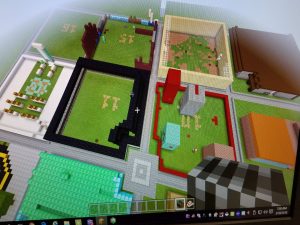In this post I will be reflecting on my learning from reading the digital ebook, Play This, Learn That, written by Dr. Chris Haskell from Boise State University.
There are different types of game-based learning. Three of those are serious games, commercial games and gamification. Serious games are those with a specific learning objective in mind, such as The Oregon Trail. Commercial games are those designed for player enjoyment that you might pick up at Gamestop or Toys R Us (not for much longer 🙁 ) Use of these games in education would require some research and changing some things about the game in order to create the educational context. Gamification is the idea of taking the mechanics of a game, such as experience points, levels or quests, and applying them to classroom experiences. In Super Mario 64, there are different levels and your goal is to collect the stars, some of which are easier to find then others. Why not adapt your Math curriculum and have students earn stars and unlock future levels of the course to make it more engaging for the students?
Contextual Transposition is the process of taking a tool that is typically used for one purpose, and using it for a different purpose or adding a new context to the utilization of said tool. In this case we might be talking about taking a commercial video game and using it for education. A couple of examples of this are The Oregon Trail and Minecraft. Minecraft, because of its open world structure, has tremendous potential for use in education. Most recently, I have utilized the City World template within Minecraft: Education Edition for a project with my students. They had to work as a team and spent time researching, brainstorming and sharing ideas on how we would design our own city. We then assigned roles and plots of land and they built their structures within the Minecraft World.
My rationale for using a commercial game in the classroom has to do with knowledge of our students. If there is a game that our students are playing outside of school that gives them enjoyment and focus, then we need to tap into that knowledge and enjoyment. We need to research why this game is so popular and what educational context we can create to have the learn within that environment that is familiar and enjoyable for them.
Play This, Learn That can be downloaded from the iTunes store and read in the iBooks app. https://itunes.apple.com/us/book/play-this-learn-that/id1000085917?mt=13
Chapter 1 – Minecraft
So, you are riding an elevator with a skeptical teacher or administrator who doesn’t quite get why Minecraft should be a tool used in the classroom. What do you tell them in response?
I would start by explaining the virtues of what this tool offers and sharing the stories of a couple creative educators who have already been successful using this tool for education. Glen Irvin from Minnesota is a Spanish language educator who was looking for a way to provide his students with a meaningful experience around the curriculum. He designed lessons and provided a learning space using Minecraft and allowed enough flexibility so students could be creative and contribute to the learning process as well.
Jim Pike is an educator from California who used Minecraft to introduce his students to multiplication by teaching them Area and Perimeter. His students learned about the content while learning to design and build a house. They are able to visualize these concepts in an engaging way and perhaps more effective than Base 10 blocks because the blocks in Minecraft are infinite and you don’t have to clean up afterwards.
Perhaps the most important reason to make use of this tool is that the kids already play this game on their own outside of school. Bringing Minecraft into the classroom with a specific educational purpose and they will buy in and the learning can take place because they are engaged.

